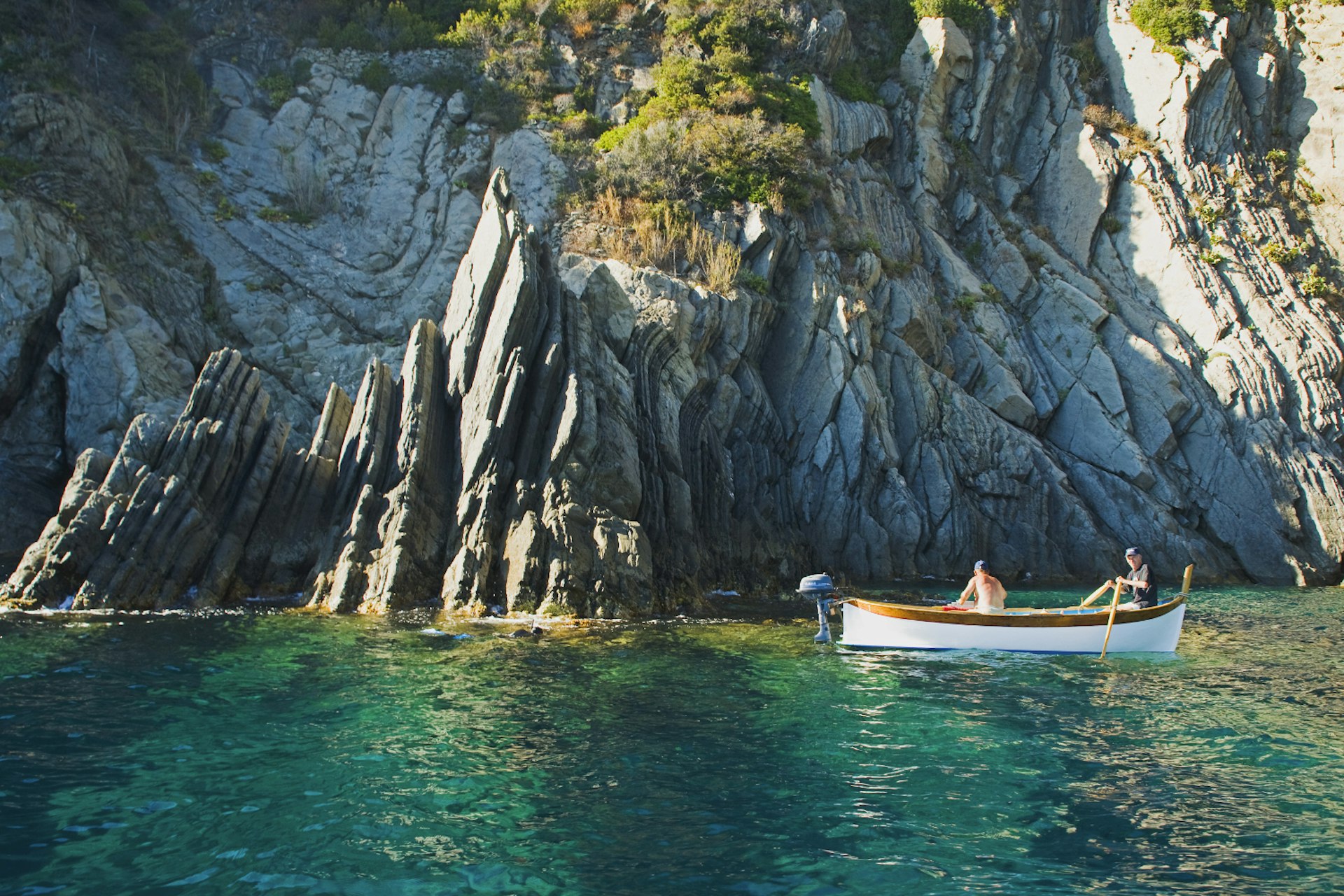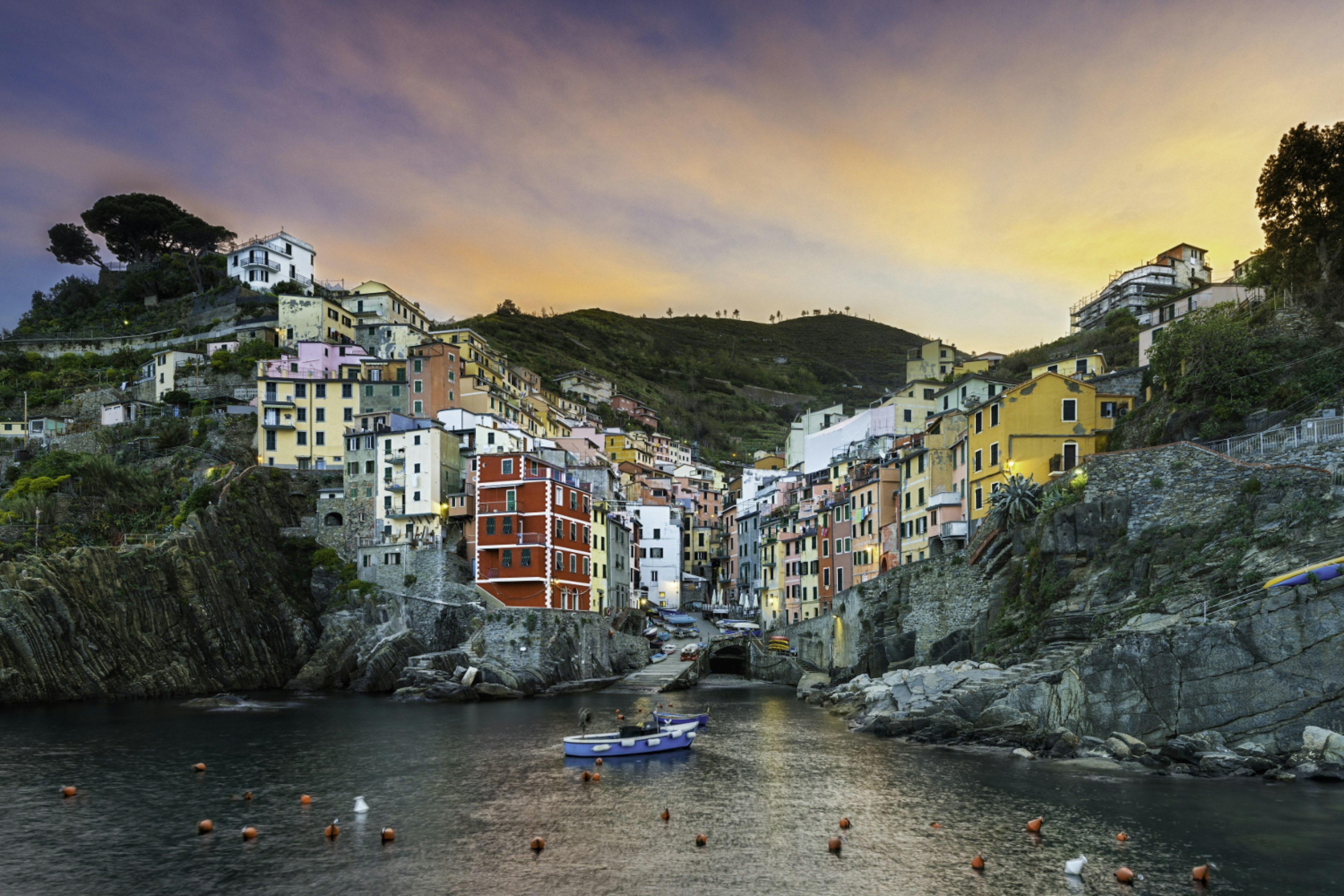The Italian Riviera is not short of rugged coastline or romantic towns and villages, but the five fishing communities of the Cinque Terre are its most iconic highlight.
Tucked away in a particularly mountainous kink at the eastern end of the Italian Riviera, the villages of the Cinque Terre (pronounced chin-kwe ter-re, with a rolled "r" sound) were shaped by their profound isolation. Set amid some of the most dramatic coastal scenery on the planet, these beautiful, colorful towns can bolster the most jaded of spirits. Sinuous paths traverse seemingly impregnable cliff sides, and a 19th-century railway line that's cut through a series of coastal tunnels moves people from village to village. Cars have been banned within the villages for more than a decade.
The five villages are no longer the isolated hamlets they once were, but there’s still a feeling of authenticity here, with few roads, perfectly preserved architecture and a network of stunning coastal and mountain trails.
What you need to know about traveling to Italy right now

Introducing Cinque Terre's five villages
Riomaggiore
Cinque Terre's easternmost village, Riomaggiore is the largest of the five and acts as its unofficial headquarters. Its peeling pastel buildings march down a steep ravine to a tiny harbor – the region's favorite postcard view – and glow romantically at sunset, which is best appreciated from the sea. A botanical garden and bird watching center sits on a rocky promontory up the hill from the pebbly Fossola Beach.

Manarola
Bequeathed with more grapevines than any other Cinque Terre village, Manarola is famous for its sweet Sciacchetrà wine. It's also awash with priceless medieval relics, supporting claims that it is the oldest village of the five. The bustling main street and waterfront promenade are still lined with fishing boats and other such reminders of everyday village life. Punta Bonfiglio, a short uphill hike, has fabulous views and a playground with a bar (or a bar with a playground, depending on your priorities).
Corniglia
Corniglia is the "quiet" middle village that sits atop a 330ft-high rocky promontory surrounded by vineyards. It is the only Cinque Terre settlement with no direct sea access, although steep steps lead down to a rocky cove. Narrow alleys and colorfully painted four-story houses characterize the ancient core, a timeless streetscape that was namechecked in Boccaccio's Decameron. Its tranquil, tangled streets lead to a broad and breezy sea-facing terrace, the only vantage point from where you can see (and photograph) all five villages at once. To reach the village proper from the railway station, you must first tackle the Lardarina, a 377-step brick stairway, or jump on a shuttle bus.

Vernazza
Vernazza's small harbor – the only secure landing point on the Cinque Terre coast – guards what is perhaps the quaintest, and steepest, of the five villages. Lined with little cafes, a main cobbled street (Via Roma) links seaside Piazza Marconi with the train station. Side streets lead to the village's trademark Genoa-style caruggi (narrow streets), where sea views pop at every turn.

Monterosso
The only Cinque Terre settlement to sport a proper stretch of beach, the westernmost village of Monterosso is the least quintessential of the quintet. The village, known for its lemon trees and anchovies, is delightful. Split in two, its new and old halves are linked by an underground tunnel burrowed beneath the blustery San Cristoforo promontory.
Best hikes in the Cinque Terre
For centuries, walking trails were the only way to travel between the villages of the Cinque Terre and often provided the only link to the outside world. Hiking here is done in the constant company of the sea, but it also offers wonderful glimpses of unique terraced farms and coastal forests.
Since the 2011 floods, many of Cinque Terre's walking paths have been in a delicate state and prone to periodic or permanent closure. Always check with the Cinque Terre National Park office before you set out. Between May and September, park guides host daily guided walks.
The Sanctuary walks
Each of the Cinque Terre’s villages is associated with a sanctuary perched high on the cliff-sides overlooking the sea. Reaching these ancient religious retreats used to be part of a hefty Catholic penance, but these days the walks through terraced vineyards with spectacular views are a lot less onerous. Most of these walks are easy, if steep, and take between 20 minutes and three hours one way.

Sentiero Azzurro (Blue Trail)
Also known as the Blue Trail and marked SVA on maps, the 7.5-mile Sentiero Azzurro, an old mule path, is the Cinque Terre’s showcase hike: narrow and precipitous but offering spectacular coastal scenery. Owing to bad storms and landslides in years past, only two sections of the trail remain open: from Monterosso to Vernazza and Vernazza to Corniglia. These parts are of low-level difficulty, though stamina is required. The Monterosso to Vernazza section is 1.8 miles (3km) and takes up to two hours. The high, forested path from Vernazza to Cornigila is 2.5 miles (4km) and usually takes about 90 minutes.
Alta Via delle Cinque Terre (Red Trail)
Experienced walkers will find it hard to resist the lure of the legendary Alta Via delle Cinque Terre, also known as the Red Trail (Sentiero Rosso) and marked AV5T on maps. Allow between nine and 12 hours to complete the 22-mile (35km) route, which runs from Porto Venere to Levanto, forming an arc high above the Cinque Terre villages. It’s mainly flat and tree-covered, with plenty of welcoming bars and restaurants along the way, but its length and various challenges mean it’s far less busy than the Blue Trail.

Where to stay in the Cinque Terre
Accommodations in the Cinque Terre are expensive, oversubscribed and often unremarkable, so it pays to seek out something special and book well in advance. Hotels can book out for the entire April to October season (as the locals laughingly say, there is no shoulder season) and are almost all closed outside of that. Alternatives are apartment rental or making your base in La Spezia or Levanto.
Great accommodation options include ultra-stylish but authentic La Mala in Vernazza, charming beachfront Hotel La Spiaggia in Monterosso, cool and contemporary Hotel Marina Piccola in Manarola or the budget Ostello di Corniglia, one of only two hostels in the Cinque Terre. If you’re looking for somewhere special, La Torretta Lodge has extraordinary views, five-star service and lavishly decorated rooms.
If you do decide to day-trip, the big but easygoing town of La Spezia is far closer than Genoa or Pisa, with just a seven-minute "commute" to the closest Cinque Terre village, Riomaggiore, and around 15 to 25 minutes to the farthest village, Monterosso. Returning at night to La Spezia’s lively bars and cheap and plentiful plates of focaccia, pesto pasta and seafood is far from a chore.

When's the best time to visit the Cinque Terre?
Spring in the Cinque Terre means cooler weather for hiking and slightly thinner crowds. In the summer months, this region is a haven for swimming and boating, but it's super hot and super crowded. Winter sees things wind down in the Cinque Terre. Hotels and many restaurants close, but there are apartment rentals for the adventurous and romantic.
When is the best time to go to Italy?
How many days to spend in Cinque Terre
The Cinque Terre is a destination with timeless appeal, and it’s impossible to do it justice in a day trip. It really is the kind of place that rewards taking it slow, whether you’re kicking back at a waterfront table in Vernazza with a glass of wine in hand or listening to birdsong and resting your weary legs at an ancient sanctuary on a clifftop high above.
Allowing three to four days will give you enough time to visit all five Cinque Terre villages, get to know the intricate twists and turns of at least one village center, and enjoy a couple of half-day hikes. If time is tight, even a single overnight stay will expose you to the villages’ gentler rhythms at dawn, dusk and midnight.

How to get to the Cinque Terre
The easiest way to reach the Cinque Terre and to travel between the villages is by train. The closest airports are in Genoa and Pisa.
Arriving in Cinque Terre by train
A train line that runs along Italy's west coast connects all five villages with Genoa, Pisa and Rome. Between 6:30am and 10pm, one to three trains an hour trundle along the coast between Genoa and La Spezia, stopping at each of Cinque Terre's villages. The good-value Cinque Terre Card offers unlimited 2nd-class train travel between Levanto and La Spezia, as well as hiking fees, or you can buy a €4 ticket for travel between any two villages.
Arriving in Cinque Terre by car
Private vehicles are not allowed beyond village entrances and on high-traffic days, roads between villages can be closed. If you're arriving by car or motorcycle, you'll need to pay to park in designated parking lots (€12 to €25 per day), though these are often full. In some villages, minibus shuttles depart from the parking lots. Check the park offices for seasonal schedules.
Although all the Cinque Terre villages can be reached by car, you’ll need nerves of steel for the narrow, twisting cliff-edge roads. If you’re traveling with a car, leaving it in the nearby town of La Spezia is a smart move. There are secure parking facilities at the train station.
Arriving in Cinque Terre by boat
Arriving to Cinque Terre by sea is also an option. In summer, Golfo Paradiso SNC runs boats to Cinque Terre from Genoa. Seasonal boat services to and from Santa Margherita are handled by Servizio Marittimo del Tigullio. If you want to make a glamorous entrance, you can even rent a yacht from one of those ports.
This article was originally published in March 2018.
You might also like:
You could get a huge fine if you don't wear the right shoes to Italy's Cinque Terre
9 stunning images of Cinque Terre that will have you booking your next trip
Alternative Cinque Terre: five beautiful and unspoiled Italian Riviera villages


